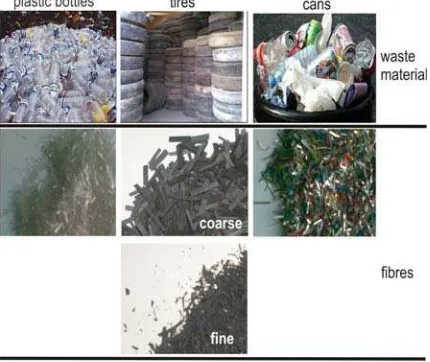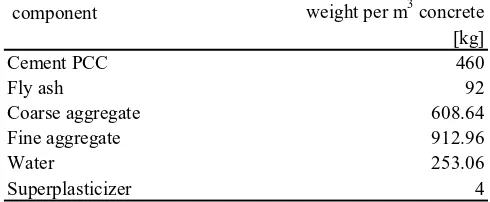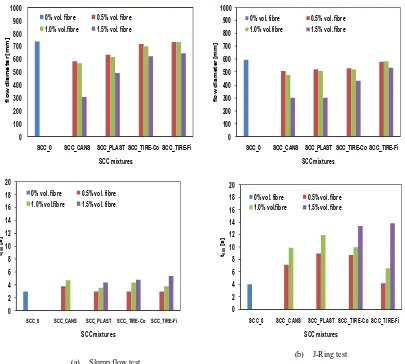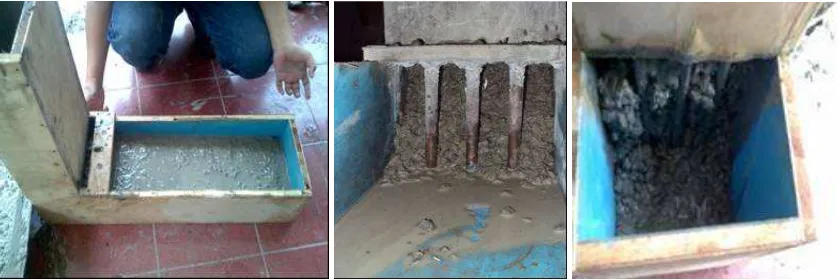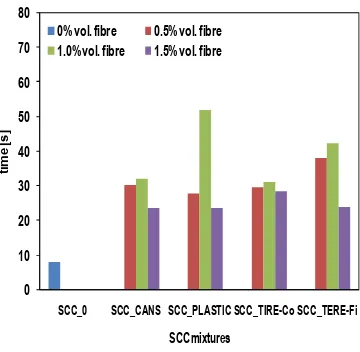The Twelfth East Asia-Pacific Conference on Structural Engineering and Construction
Fresh State Behavior of Self Compacting Concrete
Containing Waste Material Fibres
SHOLIHIN AS’AD
a*, PURNAWAN GUNAWAN
a, M. SYARIF ALAYDRUS
baDepartment of Civil Engineering, Universitas Sebelas Maret (UNS-Solo), Indonesia bPT. Wiiaya Karya Tbk. , Indonesia
Abstract
Self Compacting Concrete (SCC) mixed with fibre is the expected to be a concrete with good performance in fresh state and more enhancement in hardened concrete. This paper presents the fresh-state behavior of self compacting concrete (SCC) containing waste material fibres. Fibres were recycling product of wastes material such as, plastic bottle, rubber tire and alloy cans. Thirteen mixtures with 0.47 of water cement ratio of SCCs were added micro size (fine tire fibre) and macro (coarse tire fibre) size of rubber fibre , alloy can fibre and plastic bottle fibre with 0,5 %, 0,1 % and 1,5 % of vol. fibre dosage respectively. The macro size fibres were about 35 of fibre aspect ratio (length/diameter). One other sample was SCC without fibre as reference. The measured of concrete fresh behavior was concrete flow and passing-ability by slump flow, J-Ring, L-box, U-box and V-funnel tests. The results showed that the concrete fresh state performance decreases generally due to the increase of waste material fibre dosage and stiffer waste material fibres in SCC. The fine tire fibre recorded the best fresh state performances among SCC containing fibres and did not show much different performance compared to the SCC without fibre.
© 2011 Published by Elsevier Ltd. Selection
Keywords: concrete flow-ability, concrete passing-ability, fresh state, waste material fibres, self compacting concrete
* Corresponding author and presenter
Email: [email protected] , [email protected]
1877–7058 © 2011 Published by Elsevier Ltd. doi:10.1016/j.proeng.2011.07.101
1. Introduction
Self compacting concrete or SCC is an engineered concrete with a high performance in flow-ability and passing ability. This special fresh property enables SCC can be placed using its self weight with minimum compaction or even without compaction. Since its first application in Japan’s construction industry in the end of eighties, SCC has been applied worldwide because of its advancement to overcome the problem in heavily reinforcement, to reduce workmanship cost and to shorten the period of construction (Hela and Hubertova 2006)
In the beginning of 2000’s some researchers and companies develop the SCC technology with fibre addition into concrete to get benefit on hardened concrete property. Bestroem (2004) mixed polypropyle fibre into SCC to have fire resistance on precast concrete in Sweden while Grunert et al (2004) reported the work of pre-stressed beam made from SCC with 140 kg/m3 of steel fibre in spite of steel reinforcement bar.
However, to compose the fresh SCC with fibres is not a simple work. The fresh SCC workability is very sensitive to the solid composition change while it is well known that fibre addition into concrete will deteriorate fresh concrete workability. The SCC mixture component, the fibre material, fibre geometry and fibre dosage are main factors that must be more considered in order to keep concrete fresh property remained as self compacting (Grunwald and Walvaren 2001).
This paper reports the effect of waste material fibres on fresh property of SCC. The fibres are recycled plastic bottles, tires and cans. Some strength characteristics, eg. tensile strength and stiffness, of these waste materials are still good enough and enables them to be functioned similar to the commercial fibres. It is hoped that the application of waste materials fibres will be benefit to the hardened SCC and helps to reduce the problem of abundant waste materials.
2. Materials and Method
The used fibres were rectangular chip size of 20 mm x 2 mm plastic, tire rubber and alloy cans which were recycled from plastic bottles, tires and cans. The fine waste rubber of vulcanized tire wheel was also used. It is denoted as coarse tire fibre for chip size and fine tire fibre for fine waste vulcanized tire rubber. See Figure 1.
Thirteen SCC mixtures have been tested. Those were one mixture without fibre as reference and twelve mixtures containing fibres made from plastic bottles, cans coarse tire and fine tire with 0,5%, 1,0%
and 1,5% volume of fibre dosage respectively.Table 1 lists the mixture samples and their fibre content.
The SCC mixture component comprised PCC cement, fly ash, coarse and fine aggregate, water and
superplasticizer with 0.47 of water cement ratio.Table 2 shows the SCC mixture component.
Table 1: Type of mixtures based on fibre content
type of waste material fibre dosage
SCC_TIRE-Fi_F0.5 fine tire 0.5 < 30 < 0.20
SCC_TIRE-Fi_F1.0 fine tire 1.0 <30 < 0.20
SCC_TIRE-Fi_F1.5 fine tire 1.5 <30 < 0.20
fibre dimension
Table 2: Self-compacting concrete mixture component
component weight per m3 concrete [kg]
The measured workability parameter of fresh SCC is flow-ability, passing-ability, self-leveling and filling ability. Those are measured by slump flow, J-Ring, L-box, U-box and V-funnel test.
Slump flow test measures the SCC horizontal free flow without obstruction of bars reinforcement. This uses the conventional test apparatus with different concrete placement. The recorded of slump flow test is the t500 as indication of the time needed to pass the 500 mm of a circle mark on flow table and flow
diameter as the longest horizontal distance of spread fresh SCC after lifting up the filled Abrams cone. See Figure 2a.
J-Ring test measures the SCC horizontal flow and passing-ability with obstruction by 13 bars which
are installed circularly on flow table with 30 mm of diameter. See Figure 2b. The J-ring records the t500,
SCC spread diameter and SCC blocking height on reinforcement bars, if any.
passing the steel bar. The SCC flowing time from bars to 200 mm and 400 mm distance is recorded as t200
and t400. The self-leveling ratio is measured as the ratio fresh concrete surface at the beginning (h1) and at
the end (h2).
U-box test consist of two vertical box that measures SCC passing ability and self-leveling. The apparatus is provided with three bars and opening slide at its bottom that connects two vertical boxes components (Figure 2d). The measurement process is similar to L-box except horizontal flowing time is not recorded.
V-funnel records fresh SCC filling-ability as indicated by filling time. The V- formed funnel is provided with opening slide at the bottom. See Figure 2e. The filling time is defined as the time needed for vertical flow out from V-funnel bottom opening after it fully filled with fresh SCC.
(a) Slump flow (b) J-Ring (c) L-Box (d) U-Box (e) V-funnel Figure 2: Sketch of fresh SCC testing apparatus
3. Results and Discussion
Both fibre type and fibre dosage influenced the workability of fresh SCC. Fibres made from stiffer material such metal cans and plastic indicated stronger effect on concrete flow-ability and passing ability.
Figure 3 shows that lost of spread diameter and flow time t500of SCC are higher on mixtures containing
stiffer material cans and plastics fibres than those containing flexible material tires fibre.
Fibres restricted the mixture deformability. The fibres laid on among solid component in fresh SCC and tend to generate fibre-aggregate interlock that resisted the aggregate movement. Threfore the concrete spread with non-homogen pattern or did not form a correct circular since the fibre distribution were not homogenous. This resistance was higher on stiffer material such as metal cans and plastic. It was less circular form on concrete spread and reduced much the spread diameter. Higher fibre content restricted much concrete flow that caused higher spread diameter lost.
The higher restriction effect by stiffer fibre and much fibre content was clear on J-Ring test that measured fresh concrete flow with obstruction by some reinforcement bars. The inter-bar narrow opening potentially formed a collective aggregate barrier that reduces the fresh concrete movement. Most mixtures of stiffer fibre showed blocking since higher resistance on fresh concrete flow in bar opening. Blocking is assumed when the difference between the heights of the concrete inside and outside the J-ring is larger than 10 mm (Gruenwald and Walraven 2001). The flow time t500 of some mixtures containing 1.5% of
0
Figure 3: Influence of fibre type and dosage on the SCC flow diameter and t500 of slump flow and J-Ring test
(a) SCC without fibre (b) SCC with 1% plastic fibre
Table 3: L-box and U-box test results
sample t200 t400 h1 h2 h2/h1 remarks h1 h2 h2/h1 remarks
[s] [s] [mm] [mm] [mm] [mm]
SCC_0 3.00 5.40 105.0 95.0 0.905 OK 315.0 315.0 1.000 OK
SCC_CANS_F0.5 12.30 * 123.0 * * blocking 562.0 100.0 0.178 blocking
SCC_CANS_F1.0 * * * * * blocking 612.0 60.0 0.098 blocking
SCC_CANS_F1.5 * * * * * blocking 642.0 20.0 0.031 blocking
SCC_PLAST_F0.5 3.20 7.30 430.0 34.0 0.079 blocking 317.3 312.7 0.986 OK
SCC_PLAST_F1.0 4.00 13.70 434.0 30.0 0.069 blocking 602.0 60.0 0.100 blocking
SCC_PLAST_F1.5 20.47 * * * * blocking 642.0 20.0 0.031 blocking
SCC_TIRE‐Co_F0.5 3.00 5.70 110 90 0.818 OK 315.0 315.0 1.000 OK
SCC_TIRE‐Co_F1.0 3.70 6.22 115 85 0.739 fair 315.0 315.0 1.000 OK
SCC_TIRE‐Co_F1.5 3.73 6.57 115 85 0.739 fair 318.0 312.0 0.981 OK
SCC_TIRE‐Fi_F0.5 3.00 5.40 110 90 0.818 OK 315.0 315.0 1.000 OK
SCC_TIRE‐Fi_F1.0 3.60 5.60 100 85 0.850 OK 315.0 315.0 1.000 OK
SCC_TIRE‐Fi_F1.5 3.94 10.52 110 43 0.391 blocking 575.0 150.0 0.261 blocking
* = sample flow did not flow and fail to reach the target point for data measuring
U‐box test L‐box test
The similar fenomena was observed on the L-box and U-box test. Almost all SCC mixture with stiff fibre material did not meet the criteria of SCC that requires at least 0.8 of self leveling ratio and suitable flow passing the obstruction three reinforcement bars. High overburden effect by 600 mm height on vertical box before reinforcement bar strengthened the fibre-aggregate interlock that formed severe blocking on reinforcement bar. See figure 5b and 5c. By U-box test, only SCC with low fibre dosage 0.5% plastic fibre recorded good self leveling ratio of 0.986 .
The fibre type and fibre dosage significantly contributed to the reduction of fresh concrete flow passing the obstruction bars in bottom opening. The metal cans fibre caused all SCC mixtures stopped before reaching the 400 mm due to stronger flow restriction. See figure 5b. Flexible rubber generally was easy to deform with less fibre-aggregate locking as seen on Figure 5a. Beside that Table 3 indicated that no single samples with 1.5 % fibre met the SCC criteria due to the blocking. The higher flow time (t200 and t400) lost was recorded following the increasing fibre dosage.
(a) SCC with 1% fine tire fibre (b) blocking SCC 1% cans fibre (c) blocking on U-box test
0
Figure 6: Influence of fibre type and fibre dosage on the flow fime of SCC
Figure 6 summarizes the influence of fibre type and fibre dosage on SCC filling ability by V-funnel test. In general, the filling time of SCC with fibre was longer three to seven times compared with the plain SCC. The restrain force on SCC mixture against self weight of mixture passing the bottom funnel gate seems was not affected by fibre type. Cans, plastic and coarse tire fibre recorded not significantly different of the SCC with fibre filling time except SCC 10% that look as out-layer data.
However, the most interesting thing reported here is the lowering filling time on SC 1.5% of fibre compared to SCC1.0%. It is predicted that higher weight of SCC1.5% mixtures because of higher fibre dosage was higher on gravity force that fall it faster out of from V-funnel base gate. This prediction needs a further clarification by higher fibre content.
Among the SCC containing fibre, samples with fine tire fibre recorded the best performance in flow-ability, passing-ability and self-leveling. This fibre was made from fine crumb rubber which was flexible and enabled it to move easily among the SCC aggregate inter-space. Therefore its restrain effect due to fibre addition was the lowest among the tested waste material fibres.
4. Conclusions
From the present experimental results of this investigation, the following conclusion can be drawn a. Fibre type and fibre dosage are factors that influence of the fresh state behavior of SCC. As fibre
distributed on the space among the aggregate and fine component of SCC, its interlock with aggregate will reduce the SCC deformability. The stiffer waste fibre material makes stronger fibre-aggregate interlock and consequently develops higher resistance against SCC flow. The higher fibre dosage, the higher fibre-aggregate interlock that resists much SCC flow. This effect decreases the flow spread distance, increases flow time and tend to form blocking on reinforcement bars. Fiber decreases SCC flow-abiliy, passing-ability and self leveling ability.
generally creates coarse aggregate interlocking. However this effect is less on the flexible waste material such tire since it is flexible and easy to deform on the space of inter-aggregate of SCC. c. Mixture of SCC with fine rubber tire fibre recorded the best performance on flowability, passing
ability, self leveling compared to other SCC with fibres. This is because of it is made flexible and finer form that allow it easy and flexible to deform in inter-space of SCC aggregate.
d. The filling ability of SCC cost much time when waste material fibre is added into it. However, the fibre type does not much change the filling ability. It is important to find a detail trend by further observation with higher fiber dosage.
Acknowledgments
The authors gratefully acknowledge the support of Directorate General of Higher Education, Ministry of Education Republic of Indonesia for financial support through the Competitive Research Grant scheme in 2009-2010 and sincere thanks to Muhammad Agus Falahuddin and Kunto Adrianto for their support in laboratory work.
References
[1] Boestroem L (2004). SVB in Schweden : Polypropylenfasern erhoehen den Brandschutz von Selbstverdichtendem Beton, Beton Fertigteil (BFT), No.1. pp. 14-17.
[2] Gruenwald S and Walraven JC (2001) Parameter-study on the influence of steel fibres and coarse aggregate content on the fresh properties of self-compacting concrete. Cement and Concrete Research 31 . pp. 1793-1798.
[3] Grunert JP, Strobach CP and Teutsch (2004). Presstressed Steelfibre reinforced SCC beams without steel reinforcement, Beton Fertigteil (BFT), No. 4. pp. 50-55.
